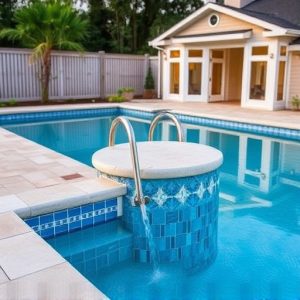Swimming Pool Alarms: Safeguarding Inground Pools & Lives
Inground swimming pools pose unique safety risks, but swimming pool alarms offer vital protection. T…….
Inground swimming pools pose unique safety risks, but swimming pool alarms offer vital protection. These alarms utilize pressure sensors and wave detectors to warn against unauthorized access or accidental falls, providing peace of mind for pool owners. Key features include waterproof designs, adjustable sensitivity, wireless connectivity, and GPS tracking via smartphones. Proper installation and regular maintenance ensure optimal performance, with early warnings reducing response times and saving lives, especially for children at risk of drowning.
Swimming pool alarms for inground pools are essential safety features, offering peace of mind for homeowners and families. With proper protection, preventing accidental drowning becomes a top priority. This comprehensive guide explores the critical role of these alarms in enhancing pool safety. From understanding the risks to navigating various alarm types and key features, this article provides an in-depth look at ensuring a secure aquatic environment. Learn how the right installation and maintenance practices, coupled with real-life success stories, make swimming pool alarms indispensable for inground pools.
Understanding Inground Pool Safety: The Need for Alarms
Inground swimming pools offer a luxurious experience, but they also present unique safety challenges. Unlike above-ground models, their depth and location within the ground can create potential hazards that require specific precautions. Understanding the risks is crucial when ensuring a secure environment for swimmers, especially children.
Swimming pool alarms for inground pools are essential safety features designed to mitigate these risks. These alarms act as vigilant sentinels, providing early warnings to potential dangers such as unauthorized access or accidental falls into the water. By integrating alarm systems, pool owners can rest assured that their loved ones are protected, fostering a sense of security and peace of mind during leisure activities.
Types of Swimming Pool Alarms: An Overview
Swimming pool alarms are an essential safety feature, particularly for in-ground pools, providing a critical early warning system to prevent accidental drowning. These alarms come in various types, each designed to detect specific hazards and trigger alerts. One common type is the pressure sensor alarm that monitors changes in water pressure, activated when someone enters the pool unexpectedly. Another is the surface wave detector, which senses disruptions on the water’s surface caused by a person’s movement, sounding an alert immediately. Additionally, some advanced systems incorporate both sensors and GPS tracking for enhanced accuracy.
For inground pools, these alarms are typically installed around the perimeter, often integrated with existing pool equipment. They can be tailored to meet specific needs, from simple doorknob-like sensors to sophisticated smart home integrations. The choice depends on factors like pool size, depth, and usage frequency. Moreover, many modern systems offer remote monitoring capabilities, allowing pool owners and lifeguards to receive alerts on their smartphones, ensuring quick response times in case of an emergency.
Key Features to Consider When Choosing an Inground Pool Alarm
When choosing a swimming pool alarm designed for inground pools, several key features should be at the forefront of your consideration. Firstly, look for alarms that offer both water-resistant and waterproof capabilities to ensure they withstand the elements and potential moisture exposure. These devices must be durable enough to handle constant submersion without compromising their functionality.
Additionally, consider alarms with adjustable sensitivity settings to cater to different pool environments. Some models incorporate advanced sensors that detect subtle movements, ideal for pools with strong currents or diving boards. Furthermore, wireless connectivity features enable real-time monitoring and alerts on your smartphone, making it easier to stay vigilant about potential risks. This technology also allows for remote arming and disarming, enhancing convenience and security.
Installation and Maintenance: Ensuring Optimal Performance
Proper installation and regular maintenance are key to ensuring that your inground pool’s alarm system functions optimally. When setting up a swimming pool alarm for an inground pool, it’s crucial to follow manufacturer guidelines meticulously. This includes correctly positioning sensors around the pool’s edge, ensuring proper wiring, and testing each component before finalizing the installation. Regular maintenance involves checking battery levels, inspecting wires for damage, and cleaning sensors to prevent false alarms. Taking these steps helps guarantee that your alarm system will accurately detect any unauthorized entry or accidental falls into the pool, providing peace of mind for you and your family.
Real-Life Scenarios: How Inground Pool Alarms Save Lives
Inground pool alarms play a vital role in water safety, especially in real-life scenarios where every second counts. These life-saving devices are designed to detect potential dangers and alert swimmers and lifeguards immediately. For instance, in a situation where a child wanders too close to the edge or an adult suffers a sudden drowning episode, swimming pool alarms can swiftly notify nearby personnel or family members, enabling prompt action.
The impact of these alarms is evident in numerous cases where they have been crucial in preventing tragic outcomes. By providing early warning signs, swimmers and caretakers can react swiftly, reducing response times and potentially saving lives. This technology offers an extra layer of protection for both supervised and unsupervised pools, making it a must-have for any homeowner or pool manager prioritizing water safety.


